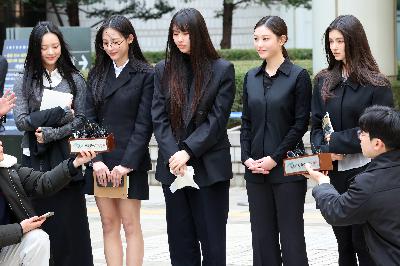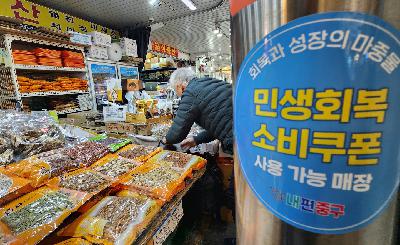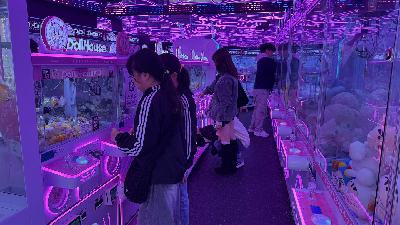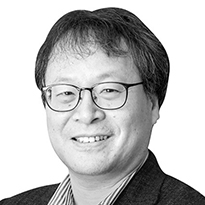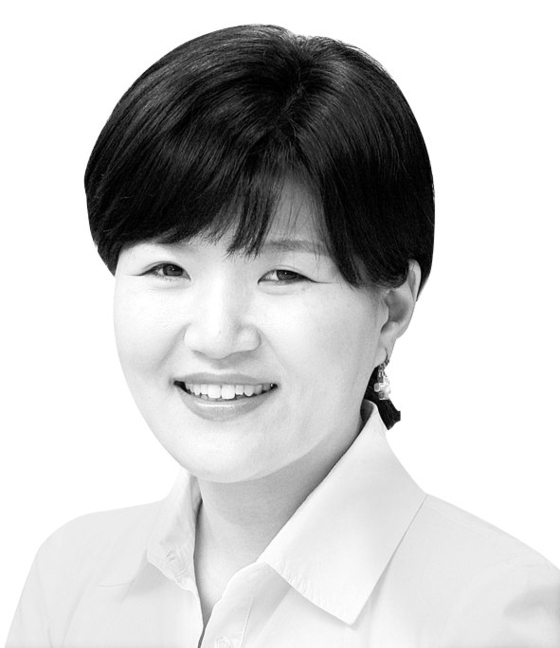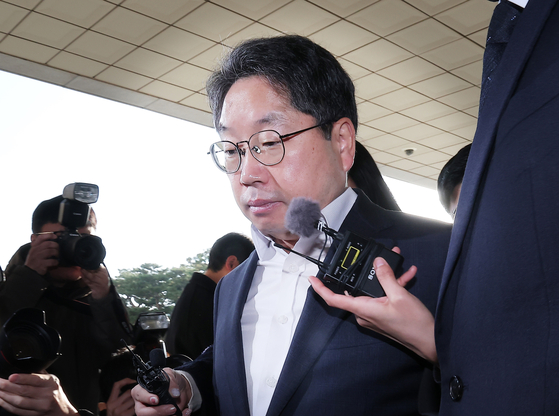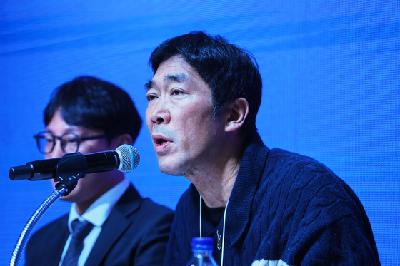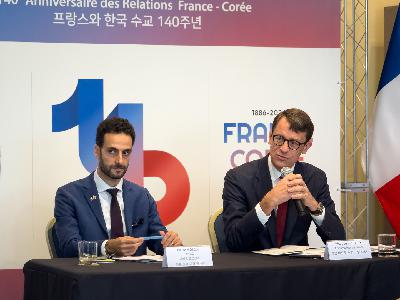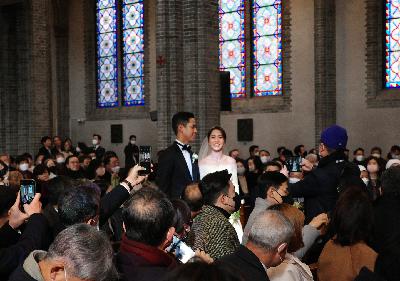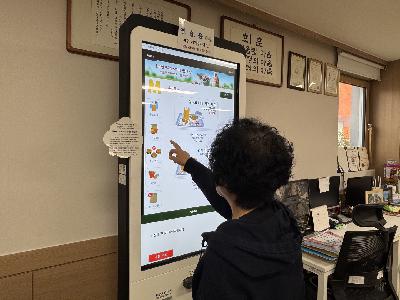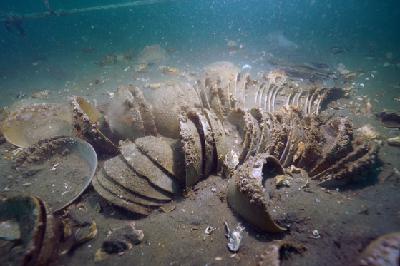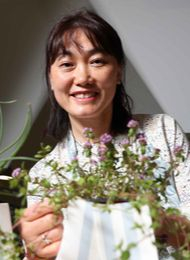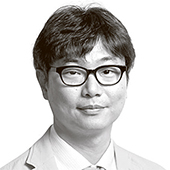Discover Korea JoongAng Daily - Daily News from Korea
Korea JoongAng Daily - Daily News from Korea

Korea JoongAng Daily - Daily News from Korea
Author: Newsroom of the Korea JoongAng Daily
Subscribed: 44Played: 7,112Subscribe
Share
© JoongAng Daily Co., Ltd.
Description
Audio recordings of the Korea JoongAng Daily's in-depth, on-the-scene news articles and features informing readers around the world of the issues of the day in Korea.
Under the slogan "Your window to Korea", the Korea JoongAng Daily is an English-language news organization focused on Korea that strives to publish factual, timely and unbiased articles.
Under the slogan "Your window to Korea", the Korea JoongAng Daily is an English-language news organization focused on Korea that strives to publish factual, timely and unbiased articles.
4597 Episodes
Reverse
This article is by Shin Ha-nee and read by an artificial voice.
NewJeans' sudden decision to return to ADOR appears to have brought a dramatic - yet controversial - end to a high-profile saga that stretched on for nearly a year, sending shock waves through the industry.
Stocks soared while fans erupted online, especially as questions mounted over the differing timing and manner of the members' return announcements.
ADOR confirmed to the Korea JoongAng Daily on Thursday that it is currently arranging separate meetings with the members, saying, "We'll do our best to ensure a successful discussion."
The reaction to the group's return has been somewhat divided among both fans and critics alike. While some welcomed the news as the long-awaited resolution to one of K-pop's biggest disputes, others questioned whether NewJeans could truly stage a seamless comeback that ADOR has insisted was possible, with some critics online arguing that the group should issue an apology before resuming activities.
A confusing return
At around 5 p.m. on Wednesday, ADOR, the K-pop label under HYBE managing NewJeans, announced that its two youngest members - Haerin, 19, and Hyein, 17 - would return to the agency and uphold their exclusive contract "after long discussions among themselves and with ADOR."
Shortly afterward, the remaining three members - Minji, Danielle and Hanni - issued a separate statement through their legal representative, released to the press, confirming their return as well and explaining that the delay was due to one member being overseas in Antarctica.
ADOR, however, stopped short of formally confirming the group's full return as a quintet, initially saying on Wednesday that it was still "reviewing the authenticity" of the statement.
According to a Yonhap report, four members, aside from the one abroad, met with ADOR CEO Lee Do-kyong on Monday to discuss the terms of reconciliation.
Former ADOR CEO Min Hee-jin, who created and led NewJeans until her ousting last year, weighed in on Thursday, saying that she "[respects] the decision by the members," and wishes them happiness.
"I can start anew anywhere," said Min. "But whatever happens, I believe NewJeans should remain whole with all five members."
A yearlong feud that rocked K-pop
The return is the first official sign of thaw in the relationship between ADOR and NewJeans since the group declared the termination of its contracts last November.
The feud began on April 22 last year, when HYBE accused then-ADOR CEO Min of attempting to seize control of the label's management. Min retaliated with a bombshell press conference, claiming HYBE had sidelined NewJeans in favor of promoting girl group Le Sserafim, and accused HYBE of copying NewJeans in another group, ILLIT.
In September, NewJeans appeared in a surprise YouTube livestream demanding HYBE reinstate Min as ADOR's CEO, citing alleged mistreatment.
Two months later, on Nov. 28, the members held a press conference, declaring that their exclusive contracts with ADOR were null and void due to the company's "breach of contract." ADOR filed a lawsuit seeking to confirm the validity of the contracts, and a Seoul court issued an injunction ordering the group to suspend independent activities.
On Oct. 30, the court ruled in favor of ADOR, stating that NewJeans must remain with the agency until the contract expires. Although the members initially said they would appeal, they took no further action and reversed course just a day before the appeal deadline.
Now what?
Despite the ongoing uncertainty, the market responded swiftly. HYBE's share rose 4.47 percent on Thursday on the Korea Exchange at 304,000 won ($207.6), after peaking at 310,000 won during trading.
Meritz Securities analyst Kim Min-young raised HYBE's 12-month target price from 370,000 won to 380,000 won in a report issued on Thursday, citing expectations of a "gradual recovery of the activities of ADOR's core IP [intellectual property]."
Kim projected potential albu...
This article is by Kim Ki-hwan and read by an artificial voice.
As the exchange rate currently hovers at the weaker end of the 1,400 won-to-dollar range, Korean companies are scrambling to finalize next year's business plans amid volatile currency swings that threaten to erode profits, deepen cost pressures for importers and expose small firms to mounting financial strain.
A manager who works in the finance team of a domestic confectionery company is struggling to finalize next year's business plan - largely due to the exchange rate.
The company relies on imports for nearly half its raw materials, including flour, corn, soybeans and sugar. A major deviation in exchange rate forecasts can severely disrupt business planning.
"Every time the exchange rate swings by 10 won, our operating profit fluctuates by billions of won," the manager said. "We're currently drafting a business plan based on three exchange rate scenarios."
As of noon Wednesday, the won-dollar exchange rate hit 1,470 won in Seoul's foreign exchange market. That marks the lowest value for the won against the dollar in about seven months since April 10. The won has largely held steady, quoted at 1,467.7 per dollar at 3:30 p.m. on Thursday. The current trend of a weakening won shows no sign of slowing after breaching the 1,400-won mark in late September.
Bank of Korea Governor Rhee Chang-yong, in an interview with Bloomberg TV Wednesday, said that the foreign exchange market is overreacting to uncertainty, attributing the won's weakness to external factors. He added that if volatility increases, authorities may intervene.
November is typically when companies are deep into planning for the following year. The exchange rate, a key variable for both exporters and importers, has become a critical point of concern.
"We buy steel materials from China in U.S. dollars, and the surge in prices has made it scary to even check the exchange rate," said a head of a ship parts company in Busan. "When the won fluctuates like this, foreign exchange losses alone can reach hundreds of millions of won. I'm starting to wonder whether planning for next year is even meaningful."
Adding to the unease is a kind of trauma from a year ago, when companies were drawing up their 2025 business plans.
The most common forecast for the exchange rate among the top 50 companies late last year was 1,350 to 1,400 won per dollar, cited by 33.3 percent of firms, according to a January analysis by the Korea Chamber of Commerce and Industry. Another 29.6 percent expected 1,300 to 1,350 won. Only 11.1 percent of Korean companies predicted the current range of 1,450 to 1,500 won.
The average exchange rate from January to this week has been 1,414 won per dollar, meaning that three out of four companies missed the mark with their forecasts.
"The exchange rate only stayed in the 1,300-won range for about three months - from May to July," said an executive at electronics company. "We've struggled all year because of the currency, and we're worried next year's forecast might be off by just much."
The implications of a 1,200-won, 1,300-won or 1,400-won exchange rate are vastly different. While this varies by product, exchange rates above 1,200 won are generally where negative impacts of a weak won become significant for importers.
Once the rate hits 1,300 won, the depreciation of the won accelerates. At the 1,400-won level, the situation is considered by many to be a crisis - at least in currency terms.
"Since the beginning of U.S. President Donald Trump's second term, the strong dollar has been steady, and the gap between the U.S. and Korea's benchmark interest rates, currently 1.5 percentage points at the upper bound, remains, so there's little to reverse the current trend of a strong dollar," said Baek Seok-hyun, a researcher at Shinhan Bank, said,
The spread between the won-dollar exchange rate's highest and lowest points this year has reached 136 won. This volatility itself has become a source of exter...
This article is by Jeong Jae-hong and read by an artificial voice.
Korea's cumulative fiscal deficit through September had exceeded 100 trillion won ($68.1 billion), the second-largest shortfall on record after 2020, when the government drafted supplementary budgets to counter the Covid-19 pandemic.
According to a report released on Thursday by the Ministry of Economy and Finance, total revenue reached 480.7 trillion won as of September, up 41.4 trillion won from a year earlier. National tax revenue rose to 289.6 trillion won, an increase of 34.3 trillion won, driven by stronger corporate earnings and a broader tax base. Corporate tax receipts jumped 21.4 trillion won, while income tax revenue climbed 10.2 trillion won, buoyed by higher bonuses, rising employment and gains from overseas stock investment.
Non-tax revenue increased 2.2 trillion won to 24.7 trillion won, and fund revenue rose 4.9 trillion won to 166.5 trillion won.
Total expenditures reached 544.2 trillion won over the same period, with 77.4 percent of the second supplementary budget executed. The consolidated fiscal balance - revenue minus expenditures - registered a deficit of 63.5 trillion won. The managed fiscal balance, which excludes the four major social security funds, posted a 102.4-trillion-won deficit, surpassing the 100-trillion-won threshold for the first time since 2020, when the shortfall hit a record 108.4 trillion won.
The deficit widened by roughly 11 trillion won from the 91.5 trillion won shortfall recorded during the same period in 2024, mainly reflecting the impact of spending under the first and second supplementary budgets.
The ministry said fiscal conditions tend to deteriorate temporarily in September due to the absence of major tax payment schedules, adding that improvements are expected to begin in October. It projected that the managed fiscal balance will converge toward the deficit level projected in the year-end budget.
Central government debt stood at 1.26 quadrillion won at the end of September, down 1.9 trillion won from August.
Treasury bond issuance in October totaled 17.7 trillion won. Treasury yields rose from the previous month amid shifting market expectations regarding monetary policy.
From January through October, government bond issuance totaled 205.2 trillion won, or 88.8 percent of the annual limit. During the same period last year, issuance came to 148.5 trillion won, or 93.8 percent of that year's ceiling.
This article was originally written in Korean and translated by a bilingual reporter with the help of generative AI tools. It was then edited by a native English-speaking editor. All AI-assisted translations are reviewed and refined by our newsroom.
This article is by Seo Ji-eun and read by an artificial voice.
SEOGWIPO, Jeju Island - Hikers setting out on the Jeju Olle Trail Route 8 will encounter 10 sculptural benches, each representing one of the Association of Southeast Asian Nations (Asean), as they follow the pristine coastal path along the famous hexagonal basalt cliffs overlooking turquoise waters in Seogwipo on Jeju Island.
A group of around 100 dignitaries and guests, including ASEAN-Korea Centre Secretary-General Kim Jae-shin, Jeju Vice Gov. Kim Ae-sook, Jeju Olle Foundation CEO Ahn Eun-joo, Asean ambassadors and their spouses and journalists from across Southeast Asia and Korea, gathered on Tuesday to commemorate the completion of the "Asean benches" - a physical tribute to people-to-people friendship, installed alphabetically along the scenic 20-kilometer (12.5-mile) trail that hugs dramatic cliffs and dips through Jeju's lush inland paths.
The project, spearheaded by the ASEAN-Korea Centre, follows the designation of Route 8 as the "ASEAN-Korea Olle" in November last year, to mark the 35th anniversary of relations. What began then as a single commemorative bench has now grown into a full symbolic circle of 10, representing the 10 original Asean member states, which grew to 11 to include Timor-Leste this year.
"A 'road' connects destinations to destinations, people to people and hearts to hearts," ASEAN-Korea Centre Secretary-General Kim said. "I hope that the 'ASEAN-Korea Olle' and the 10 Asean benches establish themselves as instruments toward the path of friendship that brings Asean and Korea even closer together."
10 benches, 10 nations
Each bench resembles a split stone - designed as two gray, smooth-cut blocks evoking Jeju's layered volcanic terrain. A blue emblem is embedded in every bench, featuring each nation's two-letter ISO country code.
Next to every bench stands a ganse - a small horse-shaped trail marker unique to Jeju Olle trails - showing travel information about the corresponding Asean country along with a QR code. Ganse means "slow-going idler" in Jeju dialect, a gentle reminder to walkers to slow down and enjoy the journey.
Inspired by Spain's Camino de Santiago, the Jeju Olle Trail is a 437-kilometer network of 27 numbered routes and a few spur trails, showcasing the island's natural beauty, culture and slow-travel philosophy.
That bench overlooks Jungmun Saekdal Beach, one of Jeju's signature shores known for its tropical palm-lined vistas and a 560-meter (1,837-foot) stretch of sands in black, white, red and gray hues. This crescent beach's famous surf breaks make it a favorite among local and international surfers and wave-seekers.
"We're happy the Malaysian bench ended up at such a strategic spot - right in front of the Parnas Hotel Jeju," Malaysian Ambassador to Korea Mohd Zamruni Khalid told the Korea JoongAng Daily, noting that the alphabetic arrangement placed Malaysia's seat in a prime location. "It's a wonderful idea. When tourists from Asean countries come to Jeju, they'll want to find their country's bench along the seaside."
The Philippines bench overlooks the Nonjitmul Spring, a tranquil spot where fresh groundwater bubbles up right by the ocean's edge to form a clear tidal pool. Here, Jeju's dramatic volcanic coastline meets a gentle oasis reminiscent of many Southeast Asian shores. Philippine Ambassador-designate to Korea Bernadette Therese C. Fernandez joked that this picturesque location was so perfect, it could serve as a filming spot, perhaps even bringing over Filipino actors to shoot a drama here.
The birth of the benches
The journey to create the ASEAN-Korea Olle Trail and its 10 nation benches all began with a casual idea from former Singaporean Ambassador Eric Teo, who suggested creating some kind of Asean marker on Jeju's famous network of trails.
Kim, who had previously spearheaded the creation of a "Korea Plaza" in the German city of Dresden during his ambassadorship there, was immediately drawn to the ...
This article is by Woo Ji-won and read by an artificial voice.
Whether to kill time, add some spark to a date or cap off a boozy night out with friends, claw machines have become a mainstream pastime in Korea in recent years. For many brave players who step up to the glass window, these machines are rarely about winning the prizes inside but about the emotional roller coaster - the flicker of hope, the inevitable disappointment and the renewed determination that leads to yet another visit to the coin exchange machine.
But not for these two.
For an online teacher surnamed Yoo and designer Kim Hye-jeong, claw machines are not just a casual activity nor a money-eating trap. Each visit ends with bagging at least 10 items, and sometimes up to 30, enough to fill three large-sized Ikea plastic bags with giant plushies. Spectators often gather as they play, watching their palm-sweating quest to pluck out one plush toy after another. The excitement contrasts game arcades elsewhere, more commonly filled with groans and sighs of defeat.
For Yoo, his journey as a claw machine expert began half a year ago, when he decided it was time to quit online gaming and go looking for a new kind of thrill. That was when he discovered claw machines.
It quickly turned into his dedicated hobby, one that now leaves the teacher in his 30s spending roughly 300,000 won ($215) per visit and walking out with plastic bags stuffed with plush toys and boxed figures. He recently went home with three full plastic bags of Kakao Friends cups, boxes of Japanese character figurines and character blankets he won at the Zzang Games arcade in Yongsan, central Seoul.
For Kim, who lives in Cheonan, South Chungcheong, it all began when she wandered into an arcade a year ago and bumped into a claw machine expert. She asked the expert for a little advice, began honing her craft and has been hooked ever since - mastering her own techniques and winning over 1,000 plush toys.
The Korea JoongAng Daily interviewed the two claw machine gurus, listened to their claw machine stories and learned, most importantly, how to win.
Q. How often do you play, and how much money do you spend each time?
A. Yoo: I go to an arcade at least once a week. I used to go more often, but I thought I needed to cut down a bit. I spend about 300,000 won each time I visit. I usually take home one to two bags of toys, with 10 products, at minimum, per visit.
Kim: Whenever I come to Seoul. Today, for example, I had an event to attend in Seoul, so I stopped by a few claw machine arcades. While I don't go regularly, when I do, I play until I am satisfied. I usually win 20 to 30 keyring plushies, sometimes more, but I try to restrain myself. I set my budget at 100,000 won and try not to go over that.
Do you have any tips or strategies for winning?
Yoo: The basic strategy is to stack the toys into a tower. But sometimes, even if you have stacked them near the exit, the top one doesn't roll in easily. That's when I use the "pulling technique," dropping the claw slightly ahead of the toy's center to drag it closer to the exit. Simply put, build a tower close to the exit, move the toy you want to the top of the tower and tap it to gradually pull it toward the exit.
There are advanced techniques like moving the claw back and forth or scooping, but for hobby players, the basic tactics are enough.
At Zzang Games arcade, it's always better to target the toys in the back. Most people go for the ones near the front, but claws often have lock mechanisms near the front that prevent them from going all the way down. Even if you grab one, it usually drops in the middle. For the ones in the back, however, the claw travels farther.
For boxes of figurines, slippery boxes are harder to grab. You need to check the spacing between the prongs. If the box is wider than the space between them, it won't come out easily.
Kim: Plushies aren't always placed straight - sometimes they're positioned diagonally. Their positions affect ...
The author is a professor at the School of Semiconductor and Display Engineering at Hallym University.
"What is the most beloved science fiction film among physicists?" To mark the centennial of quantum mechanics, a publisher posed this question to physicists around the world. The results pointed to Christopher Nolan's "Interstellar" (2014) and "The Prestige" (2006). The latter was a surprise, but "Interstellar" felt inevitable - and personally gratifying, since I have watched it about 10 times.
One reason "Interstellar" captivates scientists is the precision with which physics shapes its narrative. Guided by Nobel laureate Kip Thorne, the film incorporates complex scientific theories with meticulous care. It vividly depicts the time dilation effects predicted by Einstein's theory of relativity and emphasizes realism by muting all sound in scenes set in outer space, where no air exists to transmit sound waves.
Yet, a story built solely on physical laws would be closer to a documentary than a film. What truly distinguishes "Interstellar" is its imaginative reach - the essence of science fiction. It ventures into concepts still beyond scientific proof, such as interstellar travel through wormholes and civilizations existing in higher dimensions. In this sense, it evokes memories of "Contact" (1997), based on Carl Sagan's novel, which similarly bridges scientific rigor and human wonder.
If we were to ask physicists about the film's most memorable scene, many might cite the majestic view of the supermassive black hole Gargantua or the depiction of a wormhole's interior. For me, however, it is the quiet image of the spacecraft Endurance gliding past Saturn before entering the wormhole. The tiny vessel, moving like a speck before the immense planet, represents the fragile Earth that shelters us within a thin wall separating life from vacuum.
The power of cinematic imagination lies in its ability to stir the heart, but the realistic portrayal of the universe also teaches humility.
This article was originally written in Korean and translated by a bilingual reporter with the help of generative AI tools. It was then edited by a native English-speaking editor. All AI-assisted translations are reviewed and refined by our newsroom.
The author is a senior economic reporter at the JoongAng Ilbo.
"No taxation without representation."
The slogan, seen on license plates across Washington, D.C., still resonates in the U.S. capital today. It originated during the 18th-century American Revolution, when colonists argued that it was unjust to impose taxes on citizens without giving them a voice in government. D.C. residents continue to display it as a silent protest: Unlike the 50 states, the district pays federal taxes but has no voting representatives in Congress.
Taxes ignited the American Revolution. When Britain tried to fund its empire by taxing its colonies, American settlers resisted, arguing that any taxation by a legislature where they had no representation was illegitimate. The Boston Tea Party in 1773 symbolized that defiance.
The founding generation remembered this when establishing the United States. The Constitution explicitly vested taxing and tariff powers in Congress, not the president. Article I states that all bills to raise revenue must originate in the House of Representatives, and that Congress alone has the authority to levy and collect taxes and duties. The framers ensured that even the commander in chief could not unilaterally impose them.
That principle is now being tested. During his second term, President Donald Trump imposed tariffs on more than 100 countries, citing the International Emergency Economic Powers Act (IEEPA) rather than seeking congressional approval. How such sweeping tariffs could stand without legislative backing quickly became a matter of legal challenge. The case has now reached the U.S. Supreme Court, which is reviewing whether Trump's use of emergency powers to impose global tariffs was lawful.
During oral arguments on Nov. 5, several justices signaled skepticism. Justice Amy Coney Barrett, one of Trump's own appointees, pressed the administration's lawyer: "Are you saying the president can impose tariffs on every country - Spain, France - simply because they might threaten our defense or industrial base?"
The IEEPA authorizes the president to "investigate," "block," "regulate" or "nullify" certain actions in national emergencies - but it never mentions tariffs. Trump's team argues that "regulate" implicitly includes tariff authority, yet justices questioned that logic, noting that the law's text does not explicitly permit taxation. Given the court's emphasis on textual interpretation, the odds may not favor Trump.
After the hearing, Treasury Secretary Scott Bessent insisted he remained "very optimistic," predicting a government victory. But based on the tone of questioning, the possibility that the court could strike down Trump's tariffs cannot be ruled out.
If that happens, economic and political repercussions would be immediate. Companies might sue to recover duties already paid - roughly 280 trillion won ($200 billion) in tariffs collected by September this year. Removing one of the pillars of Trump's trade agenda would also shake his broader economic strategy. More significantly, a ruling restricting presidential power over trade would mark the first major legal limit on Trump's sweeping executive authority.
The administration is reportedly preparing a fallback plan. Experts note that several statutes still allow the president to impose tariffs, albeit within narrower bounds. Section 122 of the 1974 Trade Act authorizes up to a 15 percent tariff for 150 days to address trade imbalances or unfair practices. Section 301, which Trump used against China during his first term, remains valid, as does Section 232 of the Trade Expansion Act, which permits tariffs for national security reasons.
These alternatives require formal investigations and bureaucratic steps, but they remain potent tools. Another long-dormant law, Section 338 of the 1930 Tariff Act, lets the president impose tariffs of up to 50 percent on countries that discriminate against U.S. exports.
Still, if the Supreme Court overturns Trump's exist...
The author is the head of the editorial board at the JoongAng Ilbo.
"Do not multiply assumptions unnecessarily. The simplest explanation is most likely true."
This principle, known as Occam's razor, was introduced by 13th-century English friar William of Ockham. In seeking the cause of any event, the simplest answer often proves the most accurate.
The government's decision to forgo an appeal in the Daejang-dong corruption case has triggered a tangle of contradictory explanations. Justice Minister Jung Sung-ho said he merely advised caution but gave no instruction. Acting Prosecutor General Noh Man-seok said he received what was effectively a proposal to drop the appeal from Vice Justice Minister Lee Jin-soo. Yet Lee claimed it was a "prosecutorial decision made independently." The Democratic Party (DP) has since reframed the controversy as an act of "judicial restraint."
The common thread in all these explanations is the claim that President Lee Jae Myung was not involved. But the public's question is simple, echoing Occam's razor: "Would the prosecution have dropped the appeal if not for President Lee?" No amount of legal or procedural argument can obscure that question.
When cases grow complex, one must return to a more ancient maxim: Cui bono - who benefits? The Roman orator Cicero used it to expose motive in the courtroom, just as detectives from Sherlock Holmes to Hercule Poirot and Columbo have done in fiction.
In a recent broadcast, Woo Sang-ho, senior presidential secretary for political affairs, insisted, "Why would we help Kim Man-bae? Those people are our enemies. What benefit could the president possibly gain when all the trials have already stopped?" His logic seems sound, yet the mystery deepens. If the administration had no intention of helping the Daejang-dong figures, why did the Justice Ministry block the prosecution's appeal? And why did prosecutors ultimately back down?
The appeal's withdrawal effectively finalized acquittals for the Daejang-dong defendants on charges of breach of trust under the Act on the Aggravated Punishment of Specific Economic Crimes - the very charge that President Lee faces. Given that his own trial will resume after his presidency, it is hard to argue he had no stake in the outcome.
Instead of addressing this simple question, the ruling party has launched a war of narratives. Officials have accused protesting prosecutors of "insubordination" and branded criticism as "selective outrage," pointing to past silence under former president Yoon Suk Yeol. That silence was indeed shameful, but demanding silence again now only repeats the same political coercion. The prosecution leadership's decision to abandon the appeal exemplifies the behavior of a politically subservient institution. If prosecutors express anger at such capitulation, the DP - which has long championed prosecutorial neutrality - should be encouraging them, not condemning them.
Immanuel Kant urged that one act only according to principles that could be made universal laws. If those in power cannot apply the same standards of law and morality to themselves, silence is preferable. The question "Can your decision be applied universally?" separates justice from expedience. When it cannot be answered, law becomes the language of power. Today, the DP increasingly mirrors the old People Power Party it once opposed. The retort "You did it too" is no substitute for moral progress.
Under the Lee administration, the boundary between public and private interests in the judicial sphere has blurred. The party seeks to abolish breach-of-trust crimes and even create new "judicial distortion" offenses - legislation widely seen as serving one man's interests. The head of the Office for Government Legislation, who previously served as Lee's defense attorney, recently spoke in the National Assembly more like a personal lawyer than a public official. Though a proposed law to suspend trials was halted only after the president intervened,...
Korea's stock market is soaring. The benchmark Kospi has risen more than 70 percent this year, the highest gain among global indexes. Much of the momentum comes from the semiconductor boom driven by artificial intelligence (AI). But beneath the rally lies growing unease. Bloomberg warned on Nov. 12 that leveraged buying by Korean retail investors is surging, fueling predictions of volatility. The volatility index, VKOSPI, has spiked to 44, far above the stable range of 10 to 20, signaling heightened market sensitivity.
Investor deposits have reached a record 88 trillion won ($60 billion), and margin loans stand at 26 trillion won. The ratio of margin loans to deposits is about 30 percent. Some analysts say this is not yet alarming, but the surge in debt-financed investing is amplifying market swings. Michael Burry, the investor portrayed in "The Big Short" (2015), has cautioned that "Big Tech profits are inflated," warning of an AI-driven bubble. A global correction could hit Korea's market hard.
Despite these risks, the government appears determined to keep pushing stocks higher, even setting the "Kospi 5,000" as its target. Officials are also reportedly considering expanding the National Pension Service's domestic equity investment limit. A senior financial regulator's recent comment that "leveraged investing is just another form of investment" was particularly troubling. With "FOMO" - fear of missing out - spreading among investors, the priority now should be to restrain, not encourage, margin trading. Regulators must act pre-emptively to curb risks of excessive leverage.
Authorities should start by tightening controls on margin loan limits, which are currently left largely to brokers' discretion. Loans for rapidly surging stocks need strict oversight. Strengthening investor alert systems to issue real-time warnings of overheating would help as well.
A continued rise in share prices would be welcome, but without stronger corporate fundamentals or broader economic growth, this rally risks being a "policy-driven bubble." Korea has seen this before. In the late 1980s, the Kospi soared from 164 at the end of 1985 to over 900 within five years, a 525 percent increase, before crashing to around 600 when the "three lows" economic boom - fueled by low oil prices, low interest rates and a low (weak) Korean won - collapsed. The shock was amplified by small investors who sold livestock and farmland to buy stocks. Today's market, marked by excess liquidity, rising debt-fueled investment and government obsession with index levels, carries similar warning signs.
The deeper the valley, the higher the mountain. The government and financial regulators must closely monitor leveraged investments and prepare for a potential downturn. The only way to build a sustainable bull market is through stronger economic fundamentals, not speculative borrowing. Channeling idle real estate capital into productive equity investment will matter far more than chasing symbolic milestones like "Kospi 5000."
This article was originally written in Korean and translated by a bilingual reporter with the help of generative AI tools. It was then edited by a native English-speaking editor. All AI-assisted translations are reviewed and refined by our newsroom.
This article is by Lim Jeong-won, Cho Mun-gyu and read by an artificial voice.
Acting Prosecutor General Noh Man-seok has offered to resign after coming under fire for deciding not to appeal the court ruling in the Daejang-dong land development case.
Noh was criticized by prosecutors and the People Power Party after prosecutors decided not to appeal a lower court ruling in the Daejang-dong land development scandal, which acquitted defendants of breach-of-trust charges on Oct. 31.
The Daejang-dong scandal involves allegations of preferential treatment and illicit profit-sharing in a massive development project in Seongnam, Gyeonggi, during the mayoral tenure of President Lee Jae Myung.
At 5:38 p.m. Wednesday, the spokesperson's office of the Supreme Prosecutors' Office notified reporters that "Acting Prosecutor General Noh has submitted his resignation today," adding that "he will share further remarks during his farewell ceremony."
Noh's resignation comes roughly four months after he assumed the acting role in July, following the voluntary resignation of former Prosecutor General Shim Woo-jung. After facing mounting pressure to resign, Noh took a personal day on Tuesday to consider his next steps.
At 8:40 a.m. Wednesday, he arrived at the Supreme Prosecutors' Office in Seocho District, southern Seoul. When asked by reporters about calls for his resignation and whether Vice Justice Minister Lee Jin-soo had mentioned any instructions related to prosecutorial authority, Noh walked into the building without comment.
The presidential office said late Wednesday that it would accept Noh's decision once the tendered resignation is formally submitted to the office.
The controversy erupted after the Seoul Central District Prosecutors' Office failed to file an appeal by the deadline of Saturday midnight against the verdict in the first trial of the Daejang-dong corruption case. The case involved Yoo Dong-gyu, former head of planning at Seongnam Development Corporation, Kim Man-bae and other private sector figures indicted on charges including aggravated breach of trust under the Act on the Aggravated Punishment of Specific Economic Crimes.
After public outrage over the lack of appeal, suspicions surfaced that external pressure had influenced the decision.
On Sunday, Noh addressed the matter, stating, "As with any major case, we took into account the Ministry of Justice's opinion, the intent and content of the ruling, appeal standards and the overall case history. We concluded that not appealing was appropriate."
"This decision was made under my responsibility as acting prosecutor general, in consultation with the Seoul Central District Prosecutors' Office chief," Noh added.
However, reports later revealed that Noh had spoken with Vice Justice Minister Lee Jin-soo before deciding not to appeal, intensifying suspicions of outside influence.
In a closed-door meeting the following day with directors at the Supreme Prosecutors' Office, Noh reportedly said that Vice Minister Lee "expressed concern about the appeal and presented several options, all of which effectively amounted to dropping the appeal."
The acting top prosecutor also said that the vice minister mentioned the possibility of asking the justice minister to exercise prosecutorial command authority. Vice Minister Lee has denied these claims.
Despite Noh's explanation that he chose to drop the appeal to "protect the prosecution," criticism mounted from prosecutors across ranks - from junior prosecutors to senior officials - who argued that the decision "undermined the rule of law" and demanded his resignation.
This article is by Shin Ha-nee and read by an artificial voice.
CJ ENM's music channel Mnet is facing accusations over one of its audition programs for allegedly abusing its position against an independent music label.
MPMG, one of Korea's leading non-idol music labels and a concert organizer, accused CJ ENM of unfair practices during the production of "Great Seoul Invasion" (2022), a band audition program which aired on Mnet. MPMG filed a complaint with the Fair Trade Commission on Tuesday, citing abuse of superior bargaining power under the Monopoly Regulation and Fair Trade Act.
"We [MPMG] tried to keep the program ['Great Seoul Invasion'] running by covering not only the full production costs but also the additional expenses after the shoot," said MPMG producer Lee Jong-hyun during a press conference held at the company's headquarters in western Seoul on Wednesday.
"And without paying even a penny, Mnet took the IP [intellectual property] rights," he said, referring to the show's distribution rights.
MPMG is demanding an official apology and partial reimbursement of the production costs, which it estimates to total around 5 billion won ($3.41 million).
Mnet's ongoing band audition show "Steal Heart Club," which began airing on Oct. 21, prompted MPMG to go public with its claims after three years, according to Lee.
"We thought that Mnet acting as if it has any authority in the band music scene could lead to more victims, so we had to speak up," Lee said.
"Are CJ Group Vice Chairwoman Miky Lee or Chairman Lee Jay-hyun aware of the fact that their company is basically exploiting smaller ones?"
MPMG manages band musicians and singer-songwriters such as SURL, Touched, Thornapple and Soran, and also hosts the annual Grand Mint Festival, one of the country's biggest music events for nonmainstream musicians.
According to MPMG, the label directly invested 3 billion won - or $2.05 million - in the production of "Great Seoul Invasion" as a "sponsor," but was later forced to cover an additional 2 billion won in production-related expenses after Mnet allegedly shifted costs onto the company.
"CJ, as the production company, shifted all the additional expenses [...] that it was supposed to bear by itself to MPMG, which constitutes forcing one party to provide unfair benefits," said Kim Jong-hwi, a partner lawyer at law firm Jeongdok, which represents MPMG.
MPMG also alleges that CJ forced it to use its own music distribution channel and outsourced the program's production to an external subcontractor without prior consultation.
"The essence of this case lies in the structural unfairness of major corporations exploiting smaller partners using their influence and brand power," said Kim.
CJ ENM issued an official statement denying the allegation, saying that the contract's structure was based on both parties' agreement, and that "We did our best to incorporate MPMG's requirements and ensure the program's success."
"We express deep regret over MPMG's unilateral claims that are inconsistent with the facts, and will take all necessary measures, including legal actions," the company said,
This article is by Lee Jae-lim and read by an artificial voice.
[NEWS ANALYSIS]
Elon Musk's recent decision to tap Samsung Electronics for AI5 and AI6 chips for Tesla has come as a surprise, given the lingering technology gap in custom fabrication between the Korean chip giant and Taiwan's TSMC.
The Tesla CEO cited a surge in demand for high-performing AI chips essential in self-driving cars, humanoid robots and data centers, but industry insiders say he is ultimately pursuing an end-to-end chip supply chain spanning multiple vendors to secure cost advantages and tighter control.
"The only option is to go build some, like, very big chip fab," Musk said at a recent shareholder meeting on Friday when asked about plans for Tesla's own chip factory. "And then you go to solve memory and packaging too."
That vision is some way off, however, as he has only floated Tesla's own chip factory without any indication of concrete plans or a timeline, requiring him to expand orders with Samsung.
It is a shift from the AI5 chip production trajectory Musk discussed earlier when he indicated that Taiwan's TSMC, the world's largest contract chipmaker, would exclusively handle production. Tesla will instead adopt a dual-track supply chain, splitting orders between TSMC and Samsung to stabilize production and accelerate output.
"This is a beautiful chip," Musk said in an earnings call after announcing third quarter results on Oct. 22. "I've poured so much life energy into this chip personally. I'm confident this is going to be a winner, next level. It makes sense to have both Samsung and TSMC focus on AI5."
According to Musk, AI5 chip samples will roll out next year, with mass production targeted for 2027, followed by AI6 in 2028. The contract between Tesla and Samsung is valued at $16.5 billion for now, but Musk's ambition to build Tesla's AI chip ecosystem could see that figure rise sharply.
Musk's endgame: 'Gigantic chip fab' vision
Despite dual sourcing from Samsung and TSMC, Musk insists the capacity will not be enough.
"It's basically a money-printing machine for TSMC and Samsung," he said. "The faster they make the chips, the faster we send them money - but it's still not fast enough."
Musk's eventual goal is to build a Tesla-owned mega foundry, consolidating chip design, manufacturing, memory and packaging under one roof - a facility capable of producing up to one million wafers per month.
His appetite for high-end chip supply comes at a critical juncture of his expansion of autonomous driving across the United States, as well as Tesla's Optimus robots, with third-generation mass production slated to begin late 2026. Analysts anticipate Tesla's value to be driven by advanced autonomous driving technologies and its humanoid robots, and in order for that to become a reality, they must be powered by the latest AI chips suited for Tesla software. Tesla noted that full self-driving (FSD) version 15 will represent the company's biggest upgrade since version 12, integrating much of the robotaxi-grade FSD model into the consumer version of the Optimus V3, which is expected to show vast improvements from prior generations, able to be dispatched to industry manufacturing and general purpose commodities spanning household chores, logistics and health care.
"To ensure the stable implementation of such performance improvements, large-scale AI infrastructure investment is essential," said Lee Ji-soo, an analyst at Korea Investment & Securities. "Tesla said it has expanded its AI training infrastructure to the equivalent of 81,000 H100 processors, which proves its focused commitment to improving computing capacity."
Shareholders recently approved a $1 trillion stock option compensation plan for Musk, tied to milestones such as cumulative sales of 20 million EVs, 1 million robotaxis and 1 million humanoids - a vision that entails a demand for tens of millions of AI chips in the years ahead.
Samsung: Tesla's new chip guru?
Musk's past comments about ...
This article is by Michael Lee and read by an artificial voice.
Korea and France are preparing to celebrate the 140th anniversary of their diplomatic relations next year with a yearlong series of cultural, scientific and economic events - and a possible visit by French President Emmanuel Macron to mark the occasion.
At a press conference at the French Embassy in Seoul on Tuesday, French Ambassador Philippe Bertoux and Cultural Counselor Pierre Morcos announced plans for more than 100 programs across 20 cities under the theme "Creativity, Opportunities, Solidarity." The initiative commemorates 140 years since the 1886 Treaty of Friendship, Commerce and Navigation was signed between France and Korea, then ruled by the Joseon Dynasty (1392-1910), establishing formal relations between the two countries.
"The 140th anniversary is more than a cultural celebration," Bertoux told reporters. "It encompasses every dimension of the two countries' relationship - political, military, economic, scientific and cultural."
The anniversary season will open in March with a concert by the Bucheon Philharmonic Orchestra and close with a ceremony in Busan in December. The main commemorative event is scheduled for June 4 at Deoksu Palace in Seoul, with additional programming in France to be announced at a Paris press conference later this year.
Morcos described the upcoming year as a "360-degree cultural season," noting that it would showcase French creativity across Korea, not just in the capital. Highlights include the opening of the Centre Pompidou Hanwha Seoul, the presentation of the Goncourt Literary Prize Korea and a French film and digital arts festival.
French-themed programs are also expected at the Busan International Dance Festival in June and the Jarasum Jazz Festival in October, while the Festival d'Avignon - France's leading performing arts event - will make its Asian debut at the Seoul Performing Arts Festival in October.
Joint projects such as the "Little Prince Art Museum" in Busan's Gamcheon Culture Village, new artist residencies in Bucheon and Busan and a virtual reality exhibition on French Impressionism at the War Memorial of Korea will also highlight Franco-Korean creative collaboration, according to the embassy.
Beyond the arts, both governments intend to use the anniversary to deepen cooperation in technology, defense and industry. High-level talks between foreign ministers will address security coordination on North Korea and efforts to stabilize supply chains for critical materials. Economic forums on "deep tech," quantum computing and space technology, along with a joint seminar between the Bank of Korea and the Bank of France, are also planned.
Bertoux confirmed that Macron's long-anticipated visit to Seoul is being arranged for next year - the first by a French president since Francois Hollande's trip in 2015. "Korea has extended an invitation for some time, and both governments are now working actively to make it happen," he said.
President Lee Jae Myung is also expected to visit France in a reciprocal trip, with discussions likely to focus on cooperation in aviation, nuclear energy, transportation and emerging technologies such as AI and advanced materials.
Bertoux emphasized that the two countries share a growing strategic alignment. "France and Korea are expanding their partnership from culture and education to security and future industries," he said, adding that Pyongyang's deepening ties with Moscow underscore the importance of greater cooperation between Seoul and Paris.
This article is by Michael Lee and read by an artificial voice.
Korea and France are preparing to celebrate the 140th anniversary of their diplomatic relations next year with a yearlong series of cultural, scientific and economic events - and a possible visit by French President Emmanuel Macron to mark the occasion.
At a press conference at the French Embassy in Seoul on Tuesday, French Ambassador Philippe Bertoux and Cultural Counselor Pierre Morcos announced plans for more than 100 programs across 20 cities under the theme "Creativity, Opportunities, Solidarity." The initiative commemorates 140 years since the 1886 Treaty of Friendship, Commerce and Navigation was signed between France and Korea, then ruled by the Joseon Dynasty (1392-1910), establishing formal relations between the two countries.
"The 140th anniversary is more than a cultural celebration," Bertoux told reporters. "It encompasses every dimension of the two countries' relationship - political, military, economic, scientific and cultural."
The anniversary season will open in March with a concert by the Bucheon Philharmonic Orchestra and close with a ceremony in Busan in December. The main commemorative event is scheduled for June 4 at Deoksu Palace in Seoul, with additional programming in France to be announced at a Paris press conference later this year.
Morcos described the upcoming year as a "360-degree cultural season," noting that it would showcase French creativity across Korea, not just in the capital. Highlights include the opening of the Centre Pompidou Hanwha Seoul, the presentation of the Goncourt Literary Prize Korea and a French film and digital arts festival.
French-themed programs are also expected at the Busan International Dance Festival in June and the Jarasum Jazz Festival in October, while the Festival d'Avignon - France's leading performing arts event - will make its Asian debut at the Seoul Performing Arts Festival in October.
Joint projects such as the "Little Prince Art Museum" in Busan's Gamcheon Culture Village, new artist residencies in Bucheon and Busan and a virtual reality exhibition on French Impressionism at the War Memorial of Korea will also highlight Franco-Korean creative collaboration, according to the embassy.
Beyond the arts, both governments intend to use the anniversary to deepen cooperation in technology, defense and industry. High-level talks between foreign ministers will address security coordination on North Korea and efforts to stabilize supply chains for critical materials. Economic forums on "deep tech," quantum computing and space technology, along with a joint seminar between the Bank of Korea and the Bank of France, are also planned.
Bertoux confirmed that Macron's long-anticipated visit to Seoul is being arranged for next year - the first by a French president since Francois Hollande's trip in 2015. "Korea has extended an invitation for some time, and both governments are now working actively to make it happen," he said.
President Lee Jae Myung is also expected to visit France in a reciprocal trip, with discussions likely to focus on cooperation in aviation, nuclear energy, transportation and emerging technologies such as AI and advanced materials.
Bertoux emphasized that the two countries share a growing strategic alignment. "France and Korea are expanding their partnership from culture and education to security and future industries," he said, adding that Pyongyang's deepening ties with Moscow underscore the importance of greater cooperation between Seoul and Paris.
This article is by Hyeon Ye-seul and read by an artificial voice.
An increasing number of family-owned conglomerate owners, heirs and relatives are marrying into the business world or nonfamily-owned conglomerate households rather than pursuing politically arranged marriages, according to a report released on Wednesday.
CEOScore, a corporate data research firm, surveyed 380 individuals from 81 family-owned business groups in 2025. The results show a generational shift in marital ties, one away from political and government circles.
Among second-generation family-owned conglomerate members, 24.1 percent had political or bureaucratic in-laws. This fell to 14.1 percent for the third generation and 6.9 percent for the fourth and fifth generations.
Notable second-generation family-owned conglomerate members that formed marital ties with political or government circles include those from HD Hyundai, LS and SK.
Chung Mong-joon, the chairman of the Asan Foundation and son of Hyundai founder Chung Ju-yung, married Kim Young-myung, the daughter of former Foreign Minister Kim Dong-jo. Koo Ja-yeol, the chairman of the LS board of directors, married Lee Hyun-joo, the daughter of Lee Jae-jeon, a former deputy chief of the presidential security service.
While marriages into political families have declined, those between business families are becoming more common. Such alliances accounted for 34.5 percent of marriages among second-generation family-owned conglomerate members, 47.9 percent in the third generation and 46.5 percent in the fourth and fifth generations.
Unions between family- and nonfamily-owned conglomerate households are also on the rise. Marriages into nonfamily-owned conglomerate households accounted for 29.3 percent of marriages among second-generation family-owned conglomerate members, dipped to 23.3 percent for the third generation, then rose again to 37.2 percent in the fourth and fifth generations.
Looking at a longer timeline, marriages into political or government families accounted for 24.2 percent of the business community before 2000. Since then, the figure has dropped to 7.4 percent. Over the same period, interbusiness marriages rose from 39.2 percent to 48 percent, and marriages with nonfamily-owned conglomerate households increased from 24.6 percent to 31.4 percent.
"Marrying into political circles used to benefit business operations," CEOScore said in the report. "But such ties now pose greater risks of regulatory scrutiny and public criticism."
LS had the most extensive network of business in-laws - connecting with Hyundai Motor, OCI, BGF, Sampyo, Sajo and the extended Dongkuk Steel family, Kisco Holdings - followed by LG and GS, each with marital ties to four other groups.
LG has ties to DL Group, Samsung, GS and Doosan, and GS is linked with LG, Sampyo, JoongAng and Taekwang. If GS's extended family is included, the group is also connected to Kumho Petrochemical and SeAH.
This article was originally written in Korean and translated by a bilingual reporter with the help of generative AI tools. It was then edited by a native English-speaking editor. All AI-assisted translations are reviewed and refined by our newsroom.
This article is by Yi Woo-lim and read by an artificial voice.
Is slimmer really better? Global smartphone makers are taking diverging approaches to the ultra-thin phone market, as both Samsung Electronics and Apple's efforts to launch slimmer models this year were met with underwhelming responses. While Samsung has paused development of a follow-up device, Apple appears determined to try again.
Tech leaker Ice Universe on Sunday revealed that Samsung's upcoming Galaxy S26 will be thinner than its predecessor. Leaked specs showed a thickness of 6.9 millimeters (0.27 inches), down from 7.2 millimeters for the S25. Samsung reportedly considered including an "Edge" successor - a dedicated slim model - in next year's lineup, while removing the "Plus" variant. Instead, the company decided to retain the current three-model lineup of base, Plus and Ultra. The slimmer design may indicate that Samsung is folding its slim-series into the base model rather than releasing a separate one.
Apple, on the other hand, seems undeterred. After introducing the iPhone Air in September - which at 5.6 millimeters was 0.2 millimeters thinner than Samsung's Edge - Apple is reportedly working on a successor. According to Chinese tech leaker Digital Chat Station, Apple is preparing the "Air 2," sharing sketches earlier this month showing the new model with two rear cameras instead of one. While details may still change, industry insiders believe rumors of the Air line being discontinued are unlikely.
Neither company achieved strong sales with their slim phones. Samsung's Edge model, released in May, sold only 1.31 million units by August, according to Hana Securities. That figure lags far behind the standard S25 model at 8.28 million units and the S25 Ultra at 12.18 million.
Apple's iPhone Air performed similarly. Japanese firm Mizuho Securities reported last month that Apple had increased production of its base, Pro and Pro Max models by two million, one million and four million units respectively, while cutting production of the Air model by one million.
Even so, Apple appears confident in pursuing the ultra-thin segment. Lee Joo-hyung, an analyst at Eugene Investment & Securities, attributed this to "Apple's strong footing in China." According to Counterpoint Research's third-quarter report released on Oct. 31, Apple was the only major smartphone brand to post growth in China. Apple's 15 percent share still trailed Vivo at 18 percent and Huawei at 16 percent, but was up about one percentage point from a year earlier. In contrast, Samsung continues to post a near-zero market share in China.
The iPhone Air even sold out within minutes of its presale launch in China on Oct. 17, suggesting Apple retains the brand power to take another shot, despite early setbacks.
Some analysts say the Air has proven more useful to Apple as a marketing tool than a commercial hit. In a report published Friday, the Wall Street Journal noted that iPhone sales have stagnated from 2021 to 2024, calling the Air the most innovative iPhone design since the iPhone X in 2017. Nabila Popal, an analyst at market research firm IDC, was quoted as saying that while the Air was not a blockbuster in sales, it was a blockbuster in marketing.
The bad news for Samsung Electronics is that other manufacturers are also entering the ultra-thin race by leveraging affordability. In October, Motorola released the Moto X70 Air at 5.99 millimeters thick. Though not the slimmest, it features a sizable 4,800-milliampere-hour battery and retails for 700 pounds ($920) in Britain - significantly cheaper than Apple's Air or Samsung's Edge, both priced at 1,199 pounds.
The strategy echoes how Chinese brands have overtaken Samsung in the foldable phone market by focusing on cost competitiveness. Huawei also released the Mate70 Air in China with a 6.6-millimeter profile and an even larger 6,500-milliampere-hour battery - not breaking the 5-millimeter threshold, but offering extended battery life as a t...
This article is by Cho Jung-woo and read by an artificial voice.
Lee Geum-ok, a 74-year-old resident of western Seoul, confidently orders an iced Americano through a kiosk screen on a Tuesday afternoon. It isn't at a cafe or restaurant. Instead, it's a senior center in Sinwol-3-dong, Yangcheon District, in western Seoul.
"We all need to learn how to use these machines since almost everywhere has them now, even restaurants," Lee said.
"Old people like us tend to forget how to use them, so we keep practicing," she added with a laugh.
For older people today, digital literacy is no longer optional. As public services, transportation systems and even basic dining increasingly rely on smartphones and automated kiosks, older people who are not familiar with such technology risk being left behind.
Like Lee and many other older Yangcheon residents, the first place they learned to use digital kiosks was at the center, at what the government calls a "smart senior center." These centers are equipped with digital devices and technologies that offer both educational programs and entertainment.
The Sinwol-dong center is one of 24 smart senior centers in Yangcheon District. In 2023, 10 were opened, and 20 more were added this year. Of them, six are still under construction but are expected to open by the end of the year, according to a district official.
As Korea officially entered a super-aging society this year - meaning that more than 20 percent of its population is 65 or older - and as digitization continues to accelerate, such centers are expanding not only in Seoul but nationwide.
Bridging the digital divide
In 2021, the Ministry of Science and ICT launched a project to convert senior centers into digital learning spaces. Since then, more than 2,000 such centers across the country have been equipped with digital devices.
The initiative comes as nearly 2.9 million out of Korea's 10 million older adults are registered members of senior centers, according to ruling Democratic Party Rep. Park Hee-seong, citing data from the Ministry of Health and Welfare. As of last year, there were 69,260 senior centers nationwide.
Yet , a gap remains. The National Information Society Agency reported last year that the digital capability index for those aged 55 and older stands at 55.4, compared to 100 for the general population.
A 2023 survey by the Ministry of Science and ICT found that nearly one in three older adults felt anxious using digital tools without help. Some have skipped meals or avoided errands because they could not navigate touch-screen menus or mobile payment systems.
In response, public institutions and private companies have launched training programs in recent years. S1, a security company under the Samsung Group, opened a digital academy for older adults in 2023.
At the Sinwol-dong center, Lee said the practice has already made a difference.
"I can confidently order a cup of coffee at a cafe now, thanks to the practice I had here," she said with a smile, tapping through menus on the kiosk. The machine includes simulations for applying for certificates at government centers, booking train tickets and ordering food.
"But ordering hamburgers and such, I'm still not used to that, since I don't usually eat them," she said.
However, as centers expand nationwide, some advocates say the programs need to go further.
During a National Assembly audit last month, the Korea Senior Citizens Association called for broader upgrades to the smart senior center model.
"Too much focus has been placed on simply installing the equipment," said Choi Woon, policy committee chair for smart senior centers at the Korea Senior Citizens Association, who appeared as a witness at the audit.
"We need a fundamental shift to expand AI caregiving and offer more diverse and meaningful content."
Maintaining health, digitally
When the center's doors opened the afternoon of Nov. 4, some 20 older adults were chatting and spending time at the center as they waited for...
This article is by Kang Hye-ran and read by an artificial voice.
The seas off Mado, an island near South Chungcheong's Taean region, were called the "graveyard of ships" by Goryeo (918-1392) and Joseon Dynasty (1392-1910) sailors for their fierce tides and violent waves. But hundreds of years later, the ships lost beneath the waves are proving to be a treasure trove of discoveries for modern-day historians.
Five shipwrecks have been found in the area alone: the famed 2007 Taean wreck loaded with 23,000 Goryeo celadon pieces, and Mado wrecks No. 1 through 4. Ten years have passed since the last and Mado wreck No. 4 was unearthed in 2015, and traces of a new sunken vessel have emerged at the same site, offering the possibility of yet another chapter in Goryeo maritime history.
The National Research Institute of Maritime Culture Heritage under the Korea Heritage Service announced that it had detected signs of an additional shipwreck while recovering structural components of the Joseon-era Mado wreck No. 4, in a press briefing held at the National Palace Museum of Korea in central Seoul on Monday.
Tentatively named Mado wreck No. 5, the new discovery included a variety of pressed-relief celadon bowls, cups and dishes - many of them made using molds. Of particular note were small celadon bowls shaped like spinning tops or conical hats, previously unseen in other Goryeo shipwrecks.
Han Seong-wook, director of the Jahyeon Ceramics Library (translated), said the pottery reflects mid-12th century styles found at kiln sites in Gangjin and Buan. "Based on the forms, the ship likely sank between 1150 and 1175," Han said.
From the site, researchers recovered 87 celadon pieces - including 65 plates, 15 bowls and 7 cups - as well as a wooden anchor, rope, rice grains, hull fragments and timber cargo supports. The composition of the cargo resembles that of Mado wrecks No. 1 and 2, suggesting the vessel was transporting grain and pottery. The celadon was of modest quality, bearing traces of bubbles and fired with a mix of high-grade quartz and mid-tier refractory clay - leading researchers to conclude it was likely intended as tableware for lower-ranking bureaucrats.
A full excavation is planned for next year. If confirmed, Mado wreck No. 5 would predate the Taean wreck (late 12th century) and Mado wrecks No. 1 (1208), No. 2 (circa 1210) and No. 3 (circa 1265-1268), making it the oldest Goryeo shipwreck discovered in the area.
Monday's briefing also included updates on Mado wreck No. 4 - the only known surviving vessel from the Joseon Dynasty. First discovered underwater in 2015, it was the first physical evidence of a segok (tax grain) transport ship, previously known only through historical records.
Wooden tags recovered from the ship (63 in total) confirmed it had departed Naju, South Jeolla, carrying tax grain and tribute bound for Gwangheungchang in Hanyang - present-day Mapo District in Seoul. Radiocarbon dating and other findings suggest the vessel sank around 1420.
Inside the ship were 152 buncheong ceramic items, including dishes labeled "Naeseom," a reference to the Naeseomsi - the royal office responsible for producing food and drink for high-ranking officials and the royal court. Various other pottery pieces were also retrieved.
Between April and October this year, the institute recovered 107 wooden structural components from the seabed, some 600 years after the ship sank. The hull, now being desalinated, measures 12 meters (39 feet) long and 5 meters wide. Researchers noted that while the port side was largely destroyed, the starboard side remained preserved up to 11 layers high - due to the ship having capsized onto its right side.
Unlike Goryeo vessels that featured a single central mast, Mado Ship No. 4 had twin masts - one at the front and one at the center - suggesting better maneuverability and speed. Its bow was constructed with horizontal timber for durability, and its hull was joined using small wooden pegs, with ir...
The author is a garden designer and the CEO of OhGardens.
Next to my husband's woodworking studio, our neighbor tends a small plot of land where a new building has yet to rise. He grows peppers and sweet potatoes and often shares his harvest with us. When I once asked if he truly enjoyed farming, his answer was simple and bright: "It's so much fun. This is what I live for." Each day he works his field, while my husband crafts with wood beside him.
Perhaps inspired by the neighbor's dedication, my husband suggested we try our own small vegetable garden this year. We planted peppers, cucumbers, Korean perilla and lettuce. As summer faded, he brought home young cabbage plants and carefully set them in the soil. From time to time, I noticed him learning from our neighbor. When he heard that slugs must be caught before dawn, he began stepping out of the house before sunrise. The cabbages grew well, and yesterday we harvested two heads. After washing them, we made fresh kimchi and used the leaves for wraps. The texture was rougher than store-bought, but the nutty flavor was so deep that it surprised us both.
That taste brought back memories of my seven years in Britain, where I studied horticulture. For students abroad, kimchi was a treasure. Back then, I only needed a mix of cabbage, fish sauce and chili powder to feel at home. Cabbage, often called a "white vegetable" for its pale leaves, originated in regions of China and southern Siberia, which explains its preference for cold weather. Because it is planted at the end of summer and harvested in autumn, it naturally became the foundation for Korea's traditional kimchi-making season.
The tightly wrapped cabbage we eat today began to be cultivated widely in the 19th century. As it grew tastier and juicier, it also attracted more insects. Some rely on pesticides, but the best way remains the most time-intensive one - checking every day and picking pests off by hand. To enjoy good cabbage, one must invest care and time.
Recent climate irregularities have reportedly cut cabbage yields sharply in recent years. I can only hope that future generations, too, will be able to experience the simple happiness of growing and savoring a single head of cabbage.
This article was originally written in Korean and translated by a bilingual reporter with the help of generative AI tools. It was then edited by a native English-speaking editor. All AI-assisted translations are reviewed and refined by our newsroom.
The author is social policy editor at the JoongAng Ilbo.
Tomorrow (Nov. 13), my daughter will sit for the College Scholastic Ability Test (CSAT), known in Korea simply as the suneung. At 8:10 a.m., when the gates close at testing sites across the country, she will be among 550,000 anxious students listening to her final instructions before starting the test. Like many parents, I will be more nervous than she is, silently wishing her luck. But it is not just families who feel the weight of this day. The nation itself slows down. Businesses open late, stock markets delay trading and flights pause during the English listening test - scenes repeated every year since the first CSAT in 1993.
Beneath its familiar surface, however, the exam has changed often - roughly twenty times over the past 32 years, almost once every two years. The CSAT my daughter takes tomorrow is very different from the one I took in 1993, the year the test began. Back then, it took place twice a year, in August and November, after criticism that one exam deciding a student's fate was too harsh. Students could use their better score for college admissions. The idea sounded fair, but poor coordination ruined it. Scores in November averaged four to six points lower than those in August, leaving many students furious that three more months of study had gone to waste.
Such unintended chaos became a recurring theme in the CSAT's history. Reforms meant to ease pressure often deepened it. This year's "social studies rush" is a case in point. Since 2022, students have been free to choose any elective subjects, regardless of their academic track, in line with a new "integrated curriculum" meant to blur the line between the humanities and sciences. But the policy backfired. Many science-track students began taking social studies instead, chasing easier grading curves. The result: students who actually took the subjects they studied in school were at a disadvantage.
The same happened a decade ago with the so-called "two-level CSAT," which offered tests of varying difficulty to ease stress for mid-tier students. It only caused confusion and was soon scrapped.
Some reforms achieved limited success but quickly lost credibility once side effects appeared. When English began to be graded on an absolute scale rather than against other students, the intention was to reduce pressure. Instead, students and private academies shifted focus to math and Korean, intensifying competition elsewhere. Parents began pushing early English education for toddlers - dubbed the "four-year-old and seven-year-old exams" - to finish English early and move on to harder subjects.
The policy linking CSAT materials to government broadcaster EBS was once hailed as a success for reducing private tutoring costs. Yet it soon created new forms of rote learning and commercial tutoring based on EBS workbooks. Again and again, reforms followed the same pattern - well-intentioned plans undone by unintended outcomes.
This is what social scientists call the "law of unintended consequences." Each policy aimed to fix a problem, but its ripple effects often worsened the system. The root cause lies in Korea's chronic "deskbound policymaking," driven by political pressure and public opinion rather than long-term research or consistency. Policymakers tinkered with the test itself while ignoring deeper structural forces: shrinking youth job markets, persistent hiring practices centered on elite universities and wide wage gaps between large and small firms.
Even as the number of students dropped from 8.27 million in 2007 to 5.68 million in 2024, total spending on private education soared from 20 trillion to 29 trillion won. Fewer competitors, yet fiercer competition - proof that the problem is not just the exam's design but the desperate drive of parents who see education as their children's only path to stability.
That is why President Lee Jae Myung's comment at his 100th-day press conference two months ago felt ...


